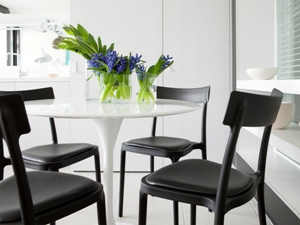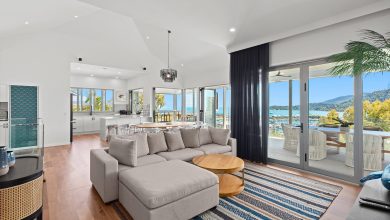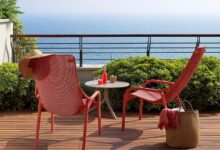
Low Odour or no Odour
Often people don’t think about the effects that paint has on their health or their revenue.
To many in the accommodation industry it’s just another wall that needs painting but what could it be doing to the health of your guests and staff? You want guests to stay and then return, not turn them away because of offensive paint smells, which they will remember especially if they suffered from them.
“Most paints release solvents into the air for months and years after painting. These are known as VOCs — volatile organic compounds — that have been shown to trigger asthma, wheeze, sinusitis and cause cancer in painters,” said Simon Winfield, sales and marketing manager of Ecolour in Byron Bay.
“Not only do they affect the health of your staff and maintenance team but they also cause a reaction in your guests that means your rooms remain unoccupied while the nasty smell goes.”
Between a quarter and a third of the population have a sensitivity to environmental pollutants, including VOCs. Painting can cause symptoms from itchy eyes, headaches, asthma etc, therefore resulting in reduction in staff productivity, staff illness and generate complaints from guests.
Mr Winfield explained that ‘low odour’ paints are an improvement over regular paints but often contain masking agents to cover the smell, which means your body doesn’t receive the warning signs to leave the room.
Ecolour manufactures paints that contains no hazardous solvents, have zero VOCs and therefore no toxic outgassing to pollute the indoor environment.
“We being used in all applications including hospitals and aged care who are able to safely reoccupy painted spaces immediately and five star resorts that check guests into rooms the same day as painting.
“One of our clients had to previously leave the painted spave to air for two to three days after using a low VOC paint. Now they get an extra two to three days of income using our Zero VOC paint range,” said Mr Winfield.
Ecolour — wholly Australian owned — is the first climate friendly paint on the market to use a waste product as a key ingredient. Backed by 20 years of research and development, the range is suitable for interior, exterior and timber finishes and the company offers a 10 year guarantee.
Selecting a healthy, dependable, and eco friendly paint takes time, unless you are equipped with the knowledge of a few key qualities that set eco paints apart from the rest.
Daniel Wurm, managing director of the not-for-profit National GreenPainters Program that provides environmentally preferable paints and coatings technology, explains, “Conventional paints can make the air you breathe a chemical cocktail long after they’ve dried, because they continue to release petroleum based solvents — VOCs— as they cure.
The VOC content of paint and the CO² emitted during manufacture are key contributors to environmental impact, primarily in the form of air-pollution (petrochemical smog) and to a lesser degree ‘greenhouse gases’. The smaller the VOC content, the less the paint is off-gassing into the surrounding atmosphere. Typical VOCs contained in paints include ammonia, acetone, toulene and xylene.
GreenPainters advise consumers and specifiers to check the VOC level of tinted paints intended for use. Even paints labelled ‘low-VOC’, often contain VOC levels over the Green Star Rating System.
‘Regular paints give off low level toxic fumes that can cause breathing irritations and headaches. Painted surfaces can continue ‘off gassing’ fumes for months after painting. The good news is that many paint companies now offer healthier low emission products for the same cost.
‘Natural’ paints, made from natural ingredients are aesthetically pleasing but not recommended for high traffic areas because they cannot tolerate continuous cleaning by harsh chemicals.
“Heat-reflective paints have even higher durability than normal paints because they resist heat build-up, often a major reason for film break-down. Heat-reflective paints, especially on the roof, not only make a massive difference to the inside temperature but they cut carbon emissions and save hundreds, sometimes thousands, of dollars on electricity bills,” continued Mr Wurm.
For outdoor decking there is a new generation of clear finishes that are called oil modified water based finishes that last up to three years. The sun’s UV rays break down the coating so regular two-three year maintenance is critical.
Safe and efficient clean up after painting is necessary because most paints contain chemicals that may be harmful if they find their way into the stormwater system, where they can eventually contaminate our waterways and bays. Even a little bit can harm plants and animals.
Michael Parry, product manager of the Australian owned Haymes Paint of Ballarat, states, “Modern water based paint technology is now equivalent or better than traditional oil or solvent based products. Traditional oil based paints used years ago were slow to dry and carried an offensive odour. Water based acrylic paint odour has decreased progressively over the last few years from where they were, but the paints themselves have good coverage and washability.
 “As most accommodation complexes are usually painted in acrylic initially there is no special preparation required, if the surfaces to be painted are clean and in good condition.” said Mr Parry.
“As most accommodation complexes are usually painted in acrylic initially there is no special preparation required, if the surfaces to be painted are clean and in good condition.” said Mr Parry.
Haymes Interior Expressions products contain no VOCs, are low odour and are accredited to Australian Paint Approval Scheme specifications, APAS accreditations are listed on the product labels. These products also meet Green Building Council VOC requirements as the colourants used are also VOC free. Low VOC paints are just as serviceable as higher VOC containing paints.
Haymes has recently introduced a range of protective coatings for more difficult applications like commercial flooring that are also low VOC. “These specialist products are designed to be safe and easy-to-use, thanks to our new water-based enviro formulation,” continued Mr Parry.
Haymes are actively and strongly committed to ensuring the environment is protected by reducing VOCs and by selecting raw materials that have improved environmental credentials as well as programs to reduce waste and offer expert advice about products and preparation.
Mr Wurm concluded, “There is no extra expense to go eco and use low-VOC paints. It is not going to cost any extra—they are the same price, extremely durable and meet all the required standards—so why wouldn’t you do it because there are so many benefits at no extra cost?”

AccomNews is not affiliated with any government agency, body or political party. We are an independently owned, family-operated magazine.







